Liverpool West Derby (UK Parliament constituency)
Liverpool, West Derby is a constituency[n 1] represented in the House of Commons of the UK Parliament since 2019 by Ian Byrne of the Labour Party.[n 2]
| Liverpool, West Derby | |
|---|---|
| Borough constituency for the House of Commons | |
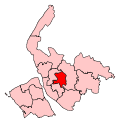 Boundary of Liverpool, West Derby in Merseyside | |
 Location of Merseyside within England | |
| County | Merseyside |
| Electorate | 62,709 (December 2010)[1] |
| Current constituency | |
| Created | 1885 |
| Member of Parliament | Ian Byrne (Labour Party) |
| Number of members | One |
| Created from | Liverpool |
Boundaries
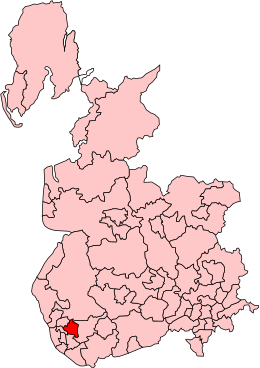
1885–1918: The Municipal Borough of Liverpool ward of West Derby.
1918–1950: The County Borough of Liverpool wards of Anfield, Breckfield, and West Derby.
1950–1955: The County Borough of Liverpool wards of Croxteth and West Derby.
1955–1983: The County Borough of Liverpool wards of Clubmoor, Croxteth, Dovecot, and Gillmoss.
1983–1997: The City of Liverpool wards of Clubmoor, Croxteth, Dovecot, Gillmoss, and Pirrie.
1997–2010: The City of Liverpool wards of Clubmoor, Croxteth, Dovecot, Gillmoss, Pirrie, and Tuebrook.
2010–present: The City of Liverpool wards of Croxteth, Knotty Ash, Norris Green, Tuebrook and Stoneycroft, West Derby, and Yew Tree.
The constituency is one of five covering the city of Liverpool and covers the northeast of the city, including Croxteth, Gillmoss, Knotty Ash, Norris Green, Tuebrook, and Stoneycroft as well as West Derby itself.
Following their review of parliamentary representation in Merseyside, the Boundary Commission created a modified West Derby constituency, which was fought at the 2010 general election. The commission's initial proposal to create a cross-border "Croxteth and Kirkby" constituency (which would have contained electoral wards from Knowsley borough, as well as from Liverpool) was dropped on its public consultation.
History
The seat was created in the Redistribution of Seats Act 1885 and can be considered a safe seat from 1964 to the present day for the Labour Party, having retained the seat at every general election since then. However, in the early-1980s, it was briefly held by the SDP as a result of sitting Labour MP Eric Ogden being among many defectors.[n 3] Labour regained the seat at the 1983 general election, where Bob Wareing won the seat back for Labour.
Before 1964, it was held by the Conservative Party, although their share of the vote has declined considerably; so much so that at four recent general elections, they have finished in fourth place; however they managed to place in third at the 2015 general election.
At the general elections of 1997 and 2001, the Liverpool West Derby seat was the only constituency in England in which a minor party finished in second place, the Liberal Party who had[n 4] all three local councillors for one electoral ward in the area.[2] At the 2005 general election, however, the Liberals were pushed into third place by the Liberal Democrats and fell to fourth place in 2015, with UKIP finishing in second place.
- Sir F E Smith
Sir Frederick Edwin Smith, then Solicitor-General in the David Lloyd George Coalition Government, was returned for Liverpool West Derby at the 1918 general election; when constituency reorganisation abolished his former neighbouring Walton seat. He sat for only two months, being promoted Lord High Chancellor of Great Britain and raised to the peerage as Lord Birkenhead in February 1919. He was the first of two MPs for this seat to achieve the highest legal office.
- David Maxwell Fyfe
Maxwell Fyfe, KC, MP from 1935-54 (including World War II) became the highest judge in the country, the Lord Chancellor, having been the Attorney General and Solicitor General for England and Wales. He helped to co-write the European Convention on Human Rights and was one of the key prosecutors at the Nuremberg Trials jointly with the (Labour-member) prosecutor Sir Hartley Shawcross. At this task was a "capable lawyer, efficient administrator and concerned housemaster".[3] There were misgivings in some quarters as to how Fyfe would perform, cross-examination not being regarded as one of his strengths. However his cross-examination of Hermann Göring is one of the most noted cross-examinations in history.[4] "Faced with sustained and methodical competence rather than brilliance, Goering...[n 5] crumbled".[5]
- Stephen Twigg
Stephen Twigg ousted Michael Portillo in the normally right-leaning Enfield Southgate seat and represented it from 1997 until the 2005 general election; briefly serving as schools minister before that year's general election, which he lost, before five years later, standing for this normally left-leaning seat in Liverpool.
Members of Parliament
| Election | Member[6] | Party | |
|---|---|---|---|
| 1885 | Lord Claud Hamilton | Conservative | |
| 1888 by-election | Hon. William Cross | Conservative | |
| 1893 by-election | Walter Long | Conservative | |
| 1900 | Samuel Higginbottom | Conservative | |
| 1903 by-election | William Rutherford | Conservative | |
| 1918 | Sir F. E. Smith, Bt | Conservative | |
| 1919 by-election | Sir Reginald Hall | Conservative | |
| 1923 | Sydney Jones | Liberal | |
| 1924 | Sir John Sandeman Allen | Conservative | |
| 1935 | David Maxwell Fyfe | Conservative | |
| 1954 by-election | John Woollam | Conservative | |
| 1964 | Eric Ogden | Labour | |
| 1981 | SDP | ||
| 1983 | Bob Wareing | Labour | |
| 2007 | Independent | ||
| 2010 | Stephen Twigg | Labour Co-operative | |
| 2019 | Ian Byrne | Labour | |
Elections
Elections in the 2010s
| Party | Candidate | Votes | % | ± | |
|---|---|---|---|---|---|
| Labour | Ian Byrne | 34,117 | 77.6 | -5.2 | |
| Conservative | Tom Bradley | 4,133 | 9.4 | -0.5 | |
| Brexit Party | Ray Pearson | 2,012 | 4.6 | N/A | |
| Liberal | Steve Radford | 1,826 | 4.2 | -0.6 | |
| Liberal Democrats | Paul Parr | 1,296 | 2.9 | +1.7 | |
| Green | Will Ward | 605 | 1.4 | +0.6 | |
| Majority | 29,984 | 68.2 | -4.7 | ||
| Turnout | 43,989 | 67.0 | -2.3 | ||
| Labour hold | Swing | ||||
| Party | Candidate | Votes | % | ± | |
|---|---|---|---|---|---|
| Labour Co-op | Stephen Twigg | 37,371 | 82.8 | +7.6 | |
| Conservative | Paul Richardson | 4,463 | 9.9 | +3.3 | |
| Liberal | Steve Radford | 2,150 | 4.8 | -0.2 | |
| Liberal Democrats | Paul Parr | 545 | 1.2 | -1.1 | |
| Green | Will Ward | 329 | 0.7 | -1.7 | |
| Independent | Graham Hughes | 305 | 0.7 | N/A | |
| Majority | 32,908 | 72.9 | +6.2 | ||
| Turnout | 45,163 | 69.0 | +2.3 | ||
| Labour Co-op hold | Swing | +2.2 | |||
Paul Parr was also the Liberal Democrat candidate at both the 2010 and 2015 general elections, when he was known as Paul Twigger.[8] Graham Hughes ran on an anti-Brexit platform as an independent in 2017, and subsequently joined the Liberal Democrats.[9]
| Party | Candidate | Votes | % | ± | |
|---|---|---|---|---|---|
| Labour Co-op | Stephen Twigg | 30,842 | 75.2 | +11.0 | |
| UKIP | Neil Miney | 3,475 | 8.5 | +5.4 | |
| Conservative | Ed McRandal | 2,710 | 6.6 | −2.6 | |
| Liberal | Steve Radford | 2,049 | 5.0 | −4.3 | |
| Green | Rebecca Lawson | 996 | 2.4 | New | |
| Liberal Democrats | Paul Twigger | 959 | 2.3 | −10.2 | |
| Majority | 27,367 | 66.7 | +16.1 | ||
| Turnout | 41,031 | 64.2 | +7.5 | ||
| Labour Co-op hold | Swing | −2.8 | |||
| Party | Candidate | Votes | % | ± | |
|---|---|---|---|---|---|
| Labour Co-op | Stephen Twigg | 22,953 | 64.1 | +3.6 | |
| Liberal Democrats | Paul Twigger | 4,486 | 12.5 | −2.7 | |
| Liberal | Steve Radford | 3,327 | 9.3 | −2.5 | |
| Conservative | Pamela Hall | 3,311 | 9.3 | +1.1 | |
| UKIP | Hilary Jones | 1,093 | 3.1 | +1.1 | |
| Socialist Labour | Kai Anderson | 614 | 1.7 | −0.6 | |
| Majority | 18,467 | 50.6 | |||
| Turnout | 35,784 | 56.7 | +11.0 | ||
| Labour Co-op hold | Swing | +3.2 | |||
Elections in the 2000s
| Party | Candidate | Votes | % | ± | |
|---|---|---|---|---|---|
| Labour | Robert Wareing | 19,140 | 62.83 | −3.4 | |
| Liberal Democrats | Patrick Moloney | 3,915 | 12.85 | +2.0 | |
| Liberal | Steve Radford | 3,606 | 11.84 | −3.1 | |
| Conservative | Peter Garrett | 2,567 | 8.4 | +0.4 | |
| Socialist Labour | Kai Anderson | 698 | 2.3 | N/A | |
| UKIP | Peter Baden | 538 | 1.8 | N/A | |
| Majority | 15,225 | 50.0 | −1.3 | ||
| Turnout | 30,464 | 47.2 | +1.7 | ||
| Labour hold | Swing | −2.7 | |||
| Party | Candidate | Votes | % | ± | |
|---|---|---|---|---|---|
| Labour | Robert Wareing | 20,454 | 66.2 | −5.0 | |
| Liberal | Steve Radford | 4,601 | 14.9 | +5.0 | |
| Liberal Democrats | Patrick Moloney | 3,366 | 10.9 | +1.9 | |
| Conservative | William Clare | 2,486 | 8.0 | −0.7 | |
| Majority | 15,853 | 51.3 | -10.3 | ||
| Turnout | 30,907 | ||||
| Labour hold | Swing | −5.0 | |||
Elections in the 1990s
| Party | Candidate | Votes | % | ± | |
|---|---|---|---|---|---|
| Labour | Robert Wareing | 30,002 | 71.2 | +3.0 | |
| Liberal | Steve Radford | 4,037 | 9.6 | +7.0 | |
| Liberal Democrats | Ann Hines | 3,805 | 9.0 | −3.2 | |
| Conservative | Neil C. Morgan | 3,656 | 8.7 | −7.9 | |
| Referendum | Peter R. Forrest | 657 | 1.6 | N/A | |
| Majority | 25,965 | 61.6 | |||
| Turnout | 42,157 | 61.3 | |||
| Labour hold | Swing | −2.0 | |||
| Party | Candidate | Votes | % | ± | |
|---|---|---|---|---|---|
| Labour | Robert Wareing | 27,014 | 68.2 | +2.9 | |
| Conservative | Stephen Fitzsimmons | 6,589 | 16.6 | −2.6 | |
| Liberal Democrats | Gillian Bundred | 4,838 | 12.2 | −3.3 | |
| Liberal | Derek Curtis | 1,021 | 2.6 | N/A | |
| Natural Law | Christopher Higgins | 154 | 0.4 | N/A | |
| Majority | 20,425 | 51.6 | +5.5 | ||
| Turnout | 39,616 | 69.8 | −3.6 | ||
| Labour hold | Swing | +2.8 | |||
Elections in the 1980s
| Party | Candidate | Votes | % | ± | |
|---|---|---|---|---|---|
| Labour | Robert Wareing | 29,021 | 65.3 | +10.8 | |
| Conservative | John Backhouse | 8,525 | 19.2 | −8.3 | |
| SDP | Malcolm Ferguson | 6,897 | 15.5 | −2.5 | |
| Majority | 20,496 | 46.1 | |||
| Turnout | 44,443 | 73.4 | |||
| Labour hold | Swing | +9.6 | |||
| Party | Candidate | Votes | % | ± | |
|---|---|---|---|---|---|
| Labour | Robert Wareing | 23,905 | 54.5 | ||
| Conservative | William M. Trelawney | 12,062 | 27.5 | ||
| SDP | Eric Ogden | 7,871 | 18.0 | ||
| Majority | 11,843 | 27.0 | |||
| Turnout | 43,838 | 69.5 | |||
| Labour hold | Swing | ||||
Elections in the 1970s
| Party | Candidate | Votes | % | ± | |
|---|---|---|---|---|---|
| Labour | Eric Ogden | 22,576 | 55.5 | −5.0 | |
| Conservative | D P M Hudson | 14,356 | 35.3 | +6.4 | |
| Liberal | A Humphreys | 3,765 | 9.3 | −1.4 | |
| Majority | 8,220 | 20.2 | −11.4 | ||
| Turnout | 40,697 | ||||
| Labour hold | Swing | ||||
| Party | Candidate | Votes | % | ± | |
|---|---|---|---|---|---|
| Labour | Eric Ogden | 23,964 | 60.48 | +5.8 | |
| Conservative | J Last | 11,445 | 28.88 | −1.8 | |
| Liberal | R Ousby | 4,215 | 10.64 | −3.1 | |
| Majority | 12,519 | 31.6 | +7.6 | ||
| Turnout | |||||
| Labour hold | Swing | ||||
| Party | Candidate | Votes | % | ± | |
|---|---|---|---|---|---|
| Labour | Eric Ogden | 22,689 | 54.68 | −2.6 | |
| Conservative | J Last | 12,716 | 30.65 | −12.0 | |
| Liberal | P. Gilchrist | 5,701 | 13.74 | N/A | |
| PEOPLE | D. Pascoe | 388 | 0.94 | N/A | |
| Majority | 9,973 | 24.0 | +9.4 | ||
| Turnout | |||||
| Labour hold | Swing | ||||
| Party | Candidate | Votes | % | ± | |
|---|---|---|---|---|---|
| Labour | Eric Ogden | 22,324 | 57.3 | +0.44 | |
| Conservative | Michael Latham | 16,619 | 42.7 | −0.4 | |
| Majority | 5,705 | 14.65 | +0.88 | ||
| Turnout | |||||
| Labour hold | Swing | ||||
Elections in the 1960s
| Party | Candidate | Votes | % | ± | |
|---|---|---|---|---|---|
| Labour | Eric Ogden | 19,988 | 56.9 | +2.2 | |
| Conservative | Peter Rees | 15,150 | 43.12 | -2.20 | |
| Majority | 4,838 | 13.8 | +4.42 | ||
| Turnout | |||||
| Labour hold | Swing | ||||
| Party | Candidate | Votes | % | ± | |
|---|---|---|---|---|---|
| Labour | Eric Ogden | 21,134 | 54.7 | +8.66 | |
| Conservative | John Woollam | 17,519 | 45.3 | -8.66 | |
| Majority | 3,615 | 9.35 | 1.43 | ||
| Turnout | |||||
| Labour gain from Conservative | Swing | ||||
Elections in the 1950s
| Party | Candidate | Votes | % | ± | |
|---|---|---|---|---|---|
| Conservative | John Woollam | 22,719 | 54.0 | +0.7 | |
| Labour | Aubrey Paxton | 19,386 | 46.0 | -0.7 | |
| Majority | 3,333 | 7.9 | +1.4 | ||
| Turnout | |||||
| Conservative hold | Swing | ||||
| Party | Candidate | Votes | % | ± | |
|---|---|---|---|---|---|
| Conservative | John Woollam | 21,124 | 53.26 | +1.34 | |
| Labour Co-op | Cyril Rawlett Fenton | 18,540 | 46.74 | -1.34 | |
| Majority | 2,584 | 6.51 | +2.67 | ||
| Turnout | |||||
| Conservative hold | Swing | ||||
| Party | Candidate | Votes | % | ± | |
|---|---|---|---|---|---|
| Conservative | John Woollam | 21,158 | 53.15 | +1.54 | |
| Labour Co-op | Cyril Rawlett Fenton | 18,650 | 46.85 | -1.54 | |
| Majority | 2,508 | 6.30 | +3.09 | ||
| Turnout | 39,808 | 58.9 | |||
| Conservative hold | Swing | ||||
| Party | Candidate | Votes | % | ± | |
|---|---|---|---|---|---|
| Conservative | David Maxwell Fyfe | 27,441 | 51.61 | ||
| Labour | Lewis C. Edwards | 25,734 | 48.39 | ||
| Majority | 1,707 | 3.21 | |||
| Turnout | 80.32 | ||||
| Conservative hold | Swing | ||||
| Party | Candidate | Votes | % | ± | |
|---|---|---|---|---|---|
| Conservative | David Maxwell Fyfe | 27,449 | 51.92 | -2.35 | |
| Labour | Bertie Kirby | 25,417 | 48.08 | -2.35 | |
| Majority | 2,032 | 3.84 | -4.69 | ||
| Turnout | |||||
| Conservative hold | Swing | ||||
Elections in the 1940s
| Party | Candidate | Votes | % | ± | |
|---|---|---|---|---|---|
| Conservative | David Maxwell Fyfe | 21,798 | 54.27 | ||
| Labour Co-op | Richard Lewis | 18,370 | 45.73 | ||
| Majority | 3,428 | 8.53 | |||
| Turnout | |||||
| Conservative hold | Swing | ||||
Elections in the 1930s
| Party | Candidate | Votes | % | ± | |
|---|---|---|---|---|---|
| Conservative | David Maxwell Fyfe | 21,196 | 58.35 | ||
| Labour | James Haworth | 10,218 | 28.13 | ||
| Liberal | Douglas Kilgour Mitchell | 4,911 | 13.52 | ||
| Majority | 10,978 | 30.22 | |||
| Turnout | 62.60 | ||||
| Conservative hold | Swing | ||||
| Party | Candidate | Votes | % | ± | |
|---|---|---|---|---|---|
| Conservative | John Sandeman Allen | 32,202 | 78.01 | ||
| Labour | Joseph Cleary | 9,077 | 21.99 | ||
| Majority | 23,125 | 56.02 | |||
| Turnout | 74.04 | ||||
| Conservative hold | Swing | ||||
Elections in the 1920s
| Party | Candidate | Votes | % | ± | |
|---|---|---|---|---|---|
| Unionist | John Sandeman Allen | 16,794 | 42.7 | −9.8 | |
| Labour | William Harvey Moore | 14,124 | 36.0 | +6.4 | |
| Liberal | Arthur Probyn Jones | 8,368 | 21.3 | +3.4 | |
| Majority | 2,670 | 6.7 | −16.2 | ||
| Turnout | 39,286 | 73.1 | −4.1 | ||
| Registered electors | 53,745 | ||||
| Unionist hold | Swing | −8.1 | |||
| Party | Candidate | Votes | % | ± | |
|---|---|---|---|---|---|
| Unionist | John Sandeman Allen | 15,667 | 52.5 | +6.7 | |
| Labour | Thomas Gallon Adams | 8,807 | 29.6 | N/A | |
| Liberal | Sydney Jones | 5,321 | 17.9 | −36.3 | |
| Majority | 6,860 | 22.9 | N/A | ||
| Turnout | 29,795 | 77.2 | +13.7 | ||
| Registered electors | 38,579 | ||||
| Unionist gain from Liberal | Swing | +21.5 | |||
| Party | Candidate | Votes | % | ± | |
|---|---|---|---|---|---|
| Liberal | Sydney Jones | 12,942 | 54.2 | N/A | |
| Unionist | Reginald Hall | 10,952 | 45.8 | −24.7 | |
| Majority | 1,990 | 8.4 | N/A | ||
| Turnout | 23,894 | 63.5 | −1.5 | ||
| Registered electors | 37,618 | ||||
| Liberal gain from Unionist | Swing | N/A | |||
| Party | Candidate | Votes | % | ± | |
|---|---|---|---|---|---|
| Unionist | Reginald Hall | 16,179 | 70.5 | +3.1 | |
| Labour | David Rowland Williams | 6,785 | 29.5 | −3.1 | |
| Majority | 9,394 | 41.0 | +6.2 | ||
| Turnout | 22,964 | 65.0 | +9.9 | ||
| Registered electors | 35,330 | ||||
| Unionist hold | Swing | +3.1 | |||
Elections in the 1910s
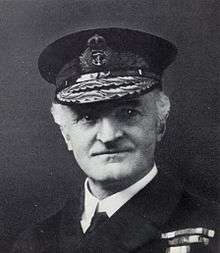
| Party | Candidate | Votes | % | ± | |
|---|---|---|---|---|---|
| C | Unionist | William Reginald Hall | 6,062 | 56.5 | −10.9 |
| Labour | George Nelson | 4,670 | 43.5 | +10.9 | |
| Majority | 1,392 | 13.0 | −21.8 | ||
| Turnout | 10,732 | 34.3 | −20.8 | ||
| Registered electors | 31,276 | ||||
| Unionist hold | Swing | −10.9 | |||
| C indicates candidate endorsed by the coalition government. | |||||
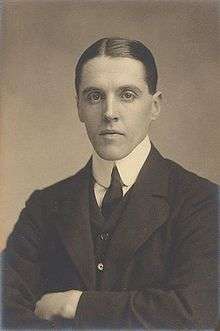
| Party | Candidate | Votes | % | ± | |
|---|---|---|---|---|---|
| C | Unionist | F. E. Smith | 11,622 | 67.4 | +4.9 |
| Labour | George Nelson | 5,618 | 32.6 | N/A | |
| Majority | 6,004 | 34.8 | +9.8 | ||
| Turnout | 17,240 | 55.1 | −13.4 | ||
| Registered electors | 31,276 | ||||
| Unionist hold | Swing | N/A | |||
| C indicates candidate endorsed by the coalition government. | |||||
| Party | Candidate | Votes | % | ± | |
|---|---|---|---|---|---|
| Conservative | William Rutherford | 4,908 | 62.5 | +4.0 | |
| Liberal | William John Lias[24] | 2,943 | 37.5 | −4.0 | |
| Majority | 1,965 | 25.0 | +8.0 | ||
| Turnout | 7,851 | 68.5 | −8.9 | ||
| Registered electors | 11,467 | ||||
| Conservative hold | Swing | +4.0 | |||
| Party | Candidate | Votes | % | ± | |
|---|---|---|---|---|---|
| Conservative | William Rutherford | 5,190 | 58.5 | −1.7 | |
| Liberal | William John Lias | 3,682 | 41.5 | +1.7 | |
| Majority | 1,508 | 17.0 | −3.4 | ||
| Turnout | 8,872 | 77.4 | +0.0 | ||
| Registered electors | 11,467 | ||||
| Conservative hold | Swing | −1.7 | |||
Elections in the 1900s
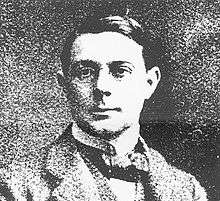
| Party | Candidate | Votes | % | ± | |
|---|---|---|---|---|---|
| Conservative | William Rutherford | 5,447 | 60.2 | N/A | |
| Liberal | Richard Durning Holt | 3,600 | 39.8 | N/A | |
| Majority | 1,847 | 20.4 | N/A | ||
| Turnout | 9,047 | 77.4 | N/A | ||
| Registered electors | 11,692 | ||||
| Conservative hold | Swing | N/A | |||
| Party | Candidate | Votes | % | ± | |
|---|---|---|---|---|---|
| Conservative | William Rutherford | 5,455 | 62.7 | N/A | |
| Liberal | Richard Durning Holt | 3,251 | 37.3 | N/A | |
| Majority | 2,204 | 25.4 | N/A | ||
| Turnout | 8,706 | 73.6 | N/A | ||
| Registered electors | 11,824 | ||||
| Conservative hold | Swing | N/A | |||
| Party | Candidate | Votes | % | ± | |
|---|---|---|---|---|---|
| Conservative | Samuel Wasse Higginbottom | Unopposed | |||
| Conservative hold | |||||
Elections in the 1890s
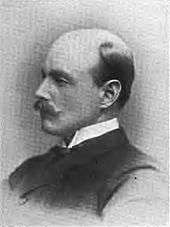
| Party | Candidate | Votes | % | ± | |
|---|---|---|---|---|---|
| Conservative | Walter Long | 4,622 | 73.3 | +14.9 | |
| Liberal | Oscar Browning | 1,686 | 26.7 | −14.9 | |
| Majority | 2,936 | 46.6 | +29.8 | ||
| Turnout | 6,308 | 59.8 | −10.7 | ||
| Registered electors | 10,556 | ||||
| Conservative hold | Swing | +14.9 | |||
| Party | Candidate | Votes | % | ± | |
|---|---|---|---|---|---|
| Conservative | Walter Long | 3,632 | 61.5 | +3.1 | |
| Liberal | Daniel Shilton Collin | 2,275 | 38.5 | −3.1 | |
| Majority | 1,357 | 23.0 | +6.2 | ||
| Turnout | 5,907 | 58.5 | −12.0 | ||
| Registered electors | 10,093 | ||||
| Conservative hold | Swing | +3.1 | |||
- Caused by Cross' death.
| Party | Candidate | Votes | % | ± | |
|---|---|---|---|---|---|
| Conservative | William Cross | 4,107 | 58.4 | −3.2 | |
| Liberal | Frederick R Smith[27] | 2,925 | 41.6 | +3.2 | |
| Majority | 1,182 | 16.8 | −6.4 | ||
| Turnout | 7,032 | 70.5 | +4.6 | ||
| Registered electors | 9,971 | ||||
| Conservative hold | Swing | −3.2 | |||
Elections in the 1880s
| Party | Candidate | Votes | % | ± | |
|---|---|---|---|---|---|
| Conservative | William Cross | Unopposed | |||
| Conservative hold | |||||
- Caused by Hamilton's resignation.
| Party | Candidate | Votes | % | ± | |
|---|---|---|---|---|---|
| Conservative | Claud Hamilton | 3,604 | 61.6 | +3.7 | |
| Liberal | Charles Hemphill[28] | 2,244 | 38.4 | −3.7 | |
| Majority | 1,360 | 23.2 | +7.4 | ||
| Turnout | 5,848 | 65.9 | −16.2 | ||
| Registered electors | 8,873 | ||||
| Conservative hold | Swing | +3.7 | |||
| Party | Candidate | Votes | % | ± | |
|---|---|---|---|---|---|
| Conservative | Claud Hamilton | 4,213 | 57.9 | N/A | |
| Liberal | Malcolm Guthrie | 3,068 | 42.1 | N/A | |
| Majority | 1,145 | 15.8 | N/A | ||
| Turnout | 7,281 | 82.1 | N/A | ||
| Registered electors | 8,873 | ||||
| Conservative win (new seat) | |||||
See also
- List of Parliamentary constituencies on Merseyside
Notes and references
- Notes
- A borough constituency (for the purposes of election expenses and type of returning officer)
- As with all constituencies, the constituency elects one Member of Parliament (MP) by the first past the post system of election at least every five years.
- See Labour Party (UK), who at the time called for withdrawal from the EEC (the Common Market) and removal of nuclear weapons during the Cold War. These considerable defections caused Labour to change its policies.
- Terms of office to date: 2003-2015
- Alternative spelling for Göring
- References
- "Electorate Figures - Boundary Commission for England". 2011 Electorate Figures. Boundary Commission for England. 4 March 2011. Archived from the original on 6 November 2010. Retrieved 13 March 2011.
- "Find Councillor". 16 June 2017.
- Tusa & Tusa (1983), p.136.
- Dutton (2004)
- Tusa & Tusa, p.287.
- Leigh Rayment's Historical List of MPs – Constituencies beginning with "W" (part 2)
- "Statement of persons nominated 2019".
- http://liverpool.gov.uk/media/1356177/sopn-nop-liverpool-west-derby.docx
- "Election results for Knotty Ash, 2 May 2019". councillors.liverpool.gov.uk. May 2, 2019.
- "Election Data 2015". Electoral Calculus. Archived from the original on 17 October 2015. Retrieved 17 October 2015.
- "Liverpool West Derby". BBC News. Retrieved 10 May 2015.
- "Election Data 2010". Electoral Calculus. Archived from the original on 26 July 2013. Retrieved 17 October 2015.
- "Election Data 2005". Electoral Calculus. Archived from the original on 15 October 2011. Retrieved 18 October 2015.
- "Election Data 2001". Electoral Calculus. Archived from the original on 15 October 2011. Retrieved 18 October 2015.
- "Election Data 1997". Electoral Calculus. Archived from the original on 15 October 2011. Retrieved 18 October 2015.
- "Election Data 1992". Electoral Calculus. Archived from the original on 15 October 2011. Retrieved 18 October 2015.
- "UK General Election results April 1992". Richard Kimber's Political Science Resources. Politics Resources. 9 April 1992. Archived from the original on 26 October 2016. Retrieved 2010-12-06.
- "Election Data 1987". Electoral Calculus. Archived from the original on 15 October 2011. Retrieved 18 October 2015.
- "Election Data 1983". Electoral Calculus. Archived from the original on 15 October 2011. Retrieved 18 October 2015.
- The Times' Guide to the House of Commons. 1955.
- British parliamentary election results 1918-1949, Craig, F.W.S.
- Craig, FWS, ed. (1974). British Parliamentary Election Results: 1885-1918. London: Macmillan Press. ISBN 9781349022984.
- Debrett's House of Commons & Judicial Bench, 1916
- ‘LIAS, William John’, Who Was Who, A & C Black, an imprint of Bloomsbury Publishing plc, 1920–2016; online edn, Oxford University Press, 2014 ; online edn, April 2014 accessed 11 Oct 2017
- The Constitutional Year Book, 1904, published by Conservative Central Office, page 170 (194 in web page)
- Debrett's House of Commons & Judicial Bench, 1896
- "Markfield". Leicester Chronicle. 25 Jun 1892. p. 8. Retrieved 22 November 2017.
- "General Election". Liverpool Mercury. 3 July 1886. pp. 5–6. Retrieved 3 December 2017 – via British Newspaper Archive.
- Debrett's House of Commons & Judicial Bench, 1886